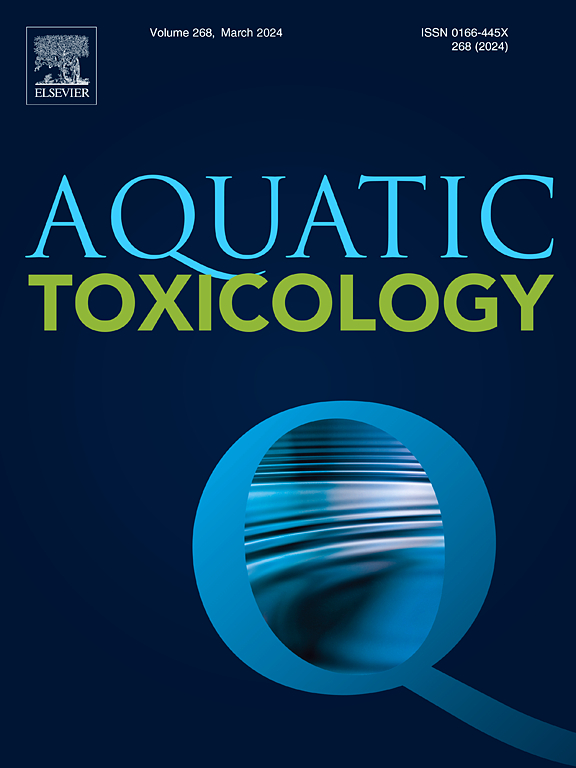The enzymatic and transcriptional adverse effects of hull in-water cleaning discharge on juvenile rockfish (Sebastes schlegeli)
IF 4.3
2区 环境科学与生态学
Q1 MARINE & FRESHWATER BIOLOGY
引用次数: 0
Abstract
The hull in-water cleaning (IWC) process creates chemical contaminants, including antifouling paint particle mixtures that are directly discharged into the coastal environment. Recent attention has also been paid to the international regulation of ship hull cleaning discharges in environmental media. However, few studies have investigated the adverse effects or toxic pathways on resident marine species. In this study, we evaluated the chemical concentration of IWC discharge in situ and its toxic effects on juvenile rockfish (Sebastes schlegeli), a major coastal fishery resource, using enzymatic and transcriptomic studies. Zinc (8.05 ± 0.96 to 189.96 ± 47.76 μg/L) was the most abundant substance in IWC discharge, followed by copper (0.87 ± 0.19 to 1.97 ± 0.60 μg/L). No mortality was observed after 7 days of exposure in any experimental group; however, reactive oxygen species and acetylcholinesterase activity varied in juvenile rockfish exposed to the highest concentration of IWC discharge (10-fold-diluted IWC discharge). The immune and detoxification systems in juvenile rockfish exposed to IWC discharge were also significantly affected in juvenile rockfish exposed to 10-fold-diluted IWC discharge (zinc: 189.96 ± 47.76 μg/L, copper: 1.97 ± 0.60 μg/L). The expression of genes related to oxidative stress, including Cu/Zn-SOD, GST, and CAT, increased significantly in fish in all the exposure groups. Specifically, brain transcriptomic analysis revealed disturbances in the nervous system and homeostatic processes. Although lethal toxicity was not significantly affected, these findings indicate the potential hazard posed by sub-lethal concentrations of IWC discharge to juvenile fish, which are at a high-level in the food chain. Our enzymatic and transcriptomic results showed that Zn-dominant IWC discharge exposure may cause neuronal and immune toxicity in marine fish species, providing relevant insights into the management of hull IWC discharge to protect coastal ecosystems against chemical contaminants.
水中清洁排放物对岩鱼幼鱼酶和转录的不利影响。
船体水中清洗(IWC)过程会产生化学污染物,包括直接排放到沿海环境中的防污涂料颗粒混合物。最近,人们还注意到对环境介质中船体清洗排放物的国际规定。然而,很少有研究调查对常驻海洋物种的不利影响或毒性途径。在本研究中,我们利用酶和转录组学研究评估了IWC原位排放的化学浓度及其对主要沿海渔业资源岩鱼幼鱼(sebases schlegeli)的毒性影响。其中,锌(8.05±0.96 ~ 189.96±47.76 μg/L)含量最高,铜(0.87±0.19 ~ 1.97±0.60 μg/L)含量次之。任何实验组暴露7天后均未见死亡;然而,暴露于高浓度IWC排放(稀释10倍IWC排放)的幼岩鱼的活性氧种类和乙酰胆碱酯酶活性发生了变化。10倍稀释的IWC排放(锌:189.96±47.76 μg/L,铜:1.97±0.60 μg/L)对IWC排放的岩鱼幼鱼的免疫和解毒系统也有显著影响。各暴露组鱼体内Cu/Zn-SOD、GST、CAT等氧化应激相关基因的表达均显著升高。具体来说,脑转录组学分析揭示了神经系统和体内平衡过程的紊乱。虽然致命毒性没有受到显著影响,但这些发现表明,IWC排放的亚致死浓度对幼鱼构成潜在危害,这在食物链中处于较高水平。我们的酶和转录组学研究结果表明,以锌为主的IWC排放暴露可能导致海洋鱼类的神经和免疫毒性,为保护沿海生态系统免受化学污染物的影响提供了相关的见解。
本文章由计算机程序翻译,如有差异,请以英文原文为准。
求助全文
约1分钟内获得全文
求助全文
来源期刊

Aquatic Toxicology
环境科学-毒理学
CiteScore
7.10
自引率
4.40%
发文量
250
审稿时长
56 days
期刊介绍:
Aquatic Toxicology publishes significant contributions that increase the understanding of the impact of harmful substances (including natural and synthetic chemicals) on aquatic organisms and ecosystems.
Aquatic Toxicology considers both laboratory and field studies with a focus on marine/ freshwater environments. We strive to attract high quality original scientific papers, critical reviews and expert opinion papers in the following areas: Effects of harmful substances on molecular, cellular, sub-organismal, organismal, population, community, and ecosystem level; Toxic Mechanisms; Genetic disturbances, transgenerational effects, behavioral and adaptive responses; Impacts of harmful substances on structure, function of and services provided by aquatic ecosystems; Mixture toxicity assessment; Statistical approaches to predict exposure to and hazards of contaminants
The journal also considers manuscripts in other areas, such as the development of innovative concepts, approaches, and methodologies, which promote the wider application of toxicological datasets to the protection of aquatic environments and inform ecological risk assessments and decision making by relevant authorities.
 求助内容:
求助内容: 应助结果提醒方式:
应助结果提醒方式:


